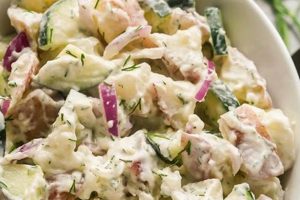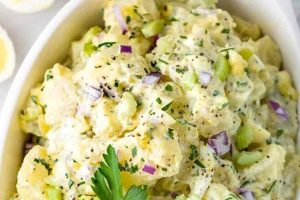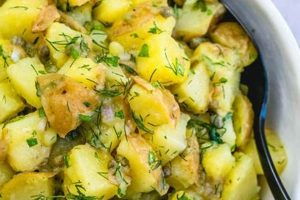A chilled seafood salad featuring tender octopus combined with cooked potatoes and often other ingredients like celery, onions, herbs, and a vinaigrette-style dressing represents a popular dish in various Mediterranean cuisines. Variations might include olives, capers, bell peppers, and different types of potatoes.
This dish offers a flavorful and refreshing culinary experience, particularly suited for warm weather. The contrasting textures of the firm octopus and tender potatoes create an appealing complexity. Octopus, as a source of lean protein and various micronutrients, contributes nutritional value. Historically, octopus has been a dietary staple in coastal communities, and combining it with locally grown vegetables like potatoes provides a naturally economical and satisfying meal.
Exploring this culinary concept further, one can delve into specific regional variations, optimal cooking techniques for achieving tender octopus, the selection of complementary ingredients, and the creation of diverse dressings to enhance the overall flavor profile.
Tips for Octopus and Potato Salad
Achieving optimal flavor and texture requires attention to key preparation steps.
Tip 1: Tenderizing the Octopus: Properly cooked octopus should be tender, not rubbery. Freezing the octopus beforehand can help break down tough fibers. Alternative tenderizing methods include simmering the octopus with a wine cork or pounding it before cooking.
Tip 2: Cooking the Octopus: Gentle simmering or braising is preferred over boiling, which can result in tough octopus. The octopus is cooked when a knife easily pierces the thickest part.
Tip 3: Potato Selection: Waxy potatoes, such as red or new potatoes, hold their shape well after cooking and are ideal for salads. Avoid starchy potatoes, which can become mushy.
Tip 4: Dressing Considerations: A vibrant vinaigrette complements the flavors of octopus and potato. Lemon juice, olive oil, herbs like parsley or oregano, and minced garlic are common components. Experimenting with red wine vinegar or adding a touch of Dijon mustard can create unique flavor profiles.
Tip 5: Adding Flavor Complexity: Ingredients such as capers, olives, chopped celery, red onion, and bell peppers provide textural and flavor contrasts, enhancing the salad’s overall appeal.
Tip 6: Timing is Key: Allow the potatoes and octopus to cool completely before combining them with the dressing and other ingredients. This prevents the potatoes from absorbing excessive dressing and becoming soggy.
Tip 7: Chilling for Optimal Flavor: Chilling the salad for at least an hour before serving allows the flavors to meld and enhances the refreshing quality of the dish.
By adhering to these guidelines, one can ensure a delicious and well-balanced octopus and potato salad, highlighting the inherent flavors of each component.
This detailed exploration of preparation techniques serves as a foundation for creating a successful and satisfying culinary experience.
1. High-quality octopus
The quality of octopus significantly impacts the overall success of an octopus and potato salad. Tenderness, flavor, and texture are key attributes directly influenced by the octopus’s freshness and sourcing. Understanding the characteristics of high-quality octopus is essential for achieving a superior culinary outcome.
- Sourcing and Freshness
Ideally, octopus should be sourced fresh from reputable fishmongers. Fresh octopus exhibits firm texture, a natural sea-like aroma, and glistening skin. Frozen octopus can be a viable alternative if handled and thawed correctly, but fresh octopus generally offers superior flavor and texture. Sourcing practices that prioritize sustainability contribute to both quality and responsible consumption.
- Appearance and Texture
High-quality octopus displays vibrant skin, free from discoloration or blemishes. The flesh should be firm and elastic, springing back when touched. Slimy or overly soft texture indicates potential quality issues. Proper handling throughout the supply chain, from fishing to market, preserves these desirable characteristics.
- Size and Type
While smaller octopuses are often preferred for salads due to their more tender texture, the species also plays a role. Certain species, like the common octopus (Octopus vulgaris), are favored for their culinary qualities. The size chosen should align with the desired presentation and cooking method.
- Preparation and Handling
Proper handling and preparation techniques are crucial for maintaining quality. Freezing prior to cooking can aid tenderization. Thorough cleaning and removal of the beak and innards are essential steps. Correct cooking methods, such as gentle simmering, ensure optimal tenderness and prevent a rubbery texture.
Selecting high-quality octopus lays the foundation for a successful octopus and potato salad. Attention to sourcing, appearance, and appropriate handling methods contributes significantly to the final dish’s overall quality, ensuring a tender, flavorful, and enjoyable culinary experience. Overlooking these factors can result in a compromised final product, regardless of other recipe components’ quality.
2. Proper cooking methods
Proper cooking methods are crucial for achieving a palatable octopus and potato salad. Octopus, if not cooked correctly, can become tough and rubbery, significantly detracting from the dish’s enjoyment. Employing appropriate techniques ensures tender, flavorful octopus that complements the other salad components. The following facets explore key considerations for cooking octopus effectively.
- Tenderizing Techniques
Tenderizing octopus before cooking contributes significantly to its final texture. Freezing the octopus overnight is a common and effective method. The freezing process helps break down tough muscle fibers, resulting in a more tender outcome. Physical tenderizing, such as pounding the octopus with a meat mallet, offers an alternative approach. These methods prepare the octopus for subsequent cooking, optimizing its texture and ensuring a more pleasant eating experience.
- Cooking Temperature and Time
Gentle, low-heat cooking is essential for tender octopus. Simmering or braising the octopus in liquid, rather than boiling, prevents it from becoming tough. Maintaining a consistent, low temperature over an extended period allows the connective tissues to break down slowly, resulting in optimal tenderness. Overcooking, conversely, can lead to a rubbery texture, negatively impacting the salad’s quality.
- Liquid Medium
The cooking liquid can contribute flavor and aid in tenderizing the octopus. Simmering the octopus in water with aromatics such as herbs, spices, or wine can infuse subtle flavors into the octopus, enhancing its complexity. Acidic liquids, such as wine or vinegar, can further aid in tenderizing, but should be used judiciously to avoid overly softening the octopus.
- Cooling and Resting
Allowing the cooked octopus to cool and rest before slicing and adding it to the salad is essential. This resting period allows the muscle fibers to relax, resulting in a more tender and flavorful final product. Rushing this step can result in a tougher texture. Cooling the octopus completely also prevents it from warming the other salad ingredients prematurely.
Mastery of these cooking methods is essential for creating a successful octopus and potato salad. Tender, flavorful octopus enhances the overall dish, complementing the other ingredients and creating a balanced and enjoyable culinary experience. Failure to employ proper cooking techniques can result in a disappointing, rubbery texture, compromising the salad’s appeal.
3. Complementary Ingredients
Complementary ingredients are essential for elevating octopus and potato salad beyond a simple combination of its core components. These additions contribute layers of flavor, texture, and visual appeal, transforming the salad into a more complex and satisfying dish. The careful selection and balance of these ingredients are crucial for achieving a harmonious and well-rounded flavor profile.
Several categories of complementary ingredients enhance octopus and potato salad. Aromatic vegetables, such as red onion, celery, and bell peppers, provide a crisp, fresh counterpoint to the tender octopus and potatoes. Briny elements, like capers, olives, and pickled vegetables, introduce a salty, tangy dimension that cuts through the richness of the octopus. Fresh herbs, including parsley, dill, and oregano, contribute bright, herbaceous notes that complement the seafood flavors. Consideration of regional variations can inspire ingredient choices; for example, a Mediterranean-inspired salad might incorporate Kalamata olives and feta cheese, while a Spanish version might include smoked paprika and chorizo.
The interplay of flavors and textures created by complementary ingredients significantly impacts the overall culinary experience. The slight bitterness of red onion, the brininess of capers, and the freshness of parsley create a dynamic flavor profile that complements the inherent flavors of octopus and potato. These additions also provide textural contrast, preventing the salad from becoming monotonous. A well-balanced octopus and potato salad exhibits a harmonious blend of flavors and textures, where each ingredient contributes to the overall composition without overpowering the others. Understanding the role and impact of complementary ingredients is essential for crafting a successful and satisfying dish.
4. Balanced Dressing
A balanced dressing is paramount in an octopus and potato salad recipe. It serves not merely as a condiment but as a unifying element, harmonizing the diverse flavors and textures of the dish. The dressing’s acidity, derived from ingredients like lemon juice or vinegar, provides brightness and cuts through the richness of the octopus. This acidity also helps to preserve the salad, acting as a mild preservative. The oil component, typically olive oil, contributes a smooth, luxurious mouthfeel and carries the flavors of other ingredients, such as garlic, herbs, and spices. A balanced dressing avoids extremes; excessive acidity can overpower the delicate octopus flavor, while too much oil can render the salad heavy and greasy. For example, a dressing with a high proportion of lemon juice might mask the subtle brininess of the octopus, while a dressing overly reliant on olive oil could overwhelm the refreshing qualities of the potatoes and other vegetables. The balance extends beyond acidity and oil; sweetness, saltiness, and spiciness, if incorporated, must also be carefully calibrated. A touch of sweetness, perhaps from a hint of honey or a finely diced shallot, can complement the natural sweetness of the octopus and potatoes, while a pinch of red pepper flakes can provide a subtle kick without overwhelming the other flavors.
Practical applications of this understanding are readily apparent in recipe development and execution. Consider a Mediterranean-style octopus and potato salad; a dressing featuring lemon juice, olive oil, oregano, and a pinch of salt enhances the natural flavors of the octopus and complements the other ingredients, such as Kalamata olives, capers, and red onion. In contrast, a Spanish-inspired version might benefit from a dressing with smoked paprika, red wine vinegar, and a touch of garlic, reflecting the bolder flavor profiles characteristic of Spanish cuisine. Understanding the interplay of these elements allows for tailored dressings that enhance, rather than detract from, the overall composition. Careful consideration of ingredient proportions is essential; even a slight imbalance can significantly impact the final result. Testing and adjusting the dressing throughout the preparation process is advisable, ensuring the desired balance is achieved.
Balancing a dressing for octopus and potato salad requires a nuanced understanding of flavor interactions and ingredient proportions. Achieving this balance elevates the dish from a simple combination of ingredients to a cohesive and flavorful culinary experience. The dressing’s role extends beyond mere flavor enhancement; it contributes to the overall texture and preservation of the salad. Challenges arise when the dressing’s components are not carefully considered, potentially overpowering delicate flavors or creating an undesirable texture. A thorough grasp of these principles allows for the creation of a dressing that not only complements the individual components but also enhances the synergy of the dish as a whole.
5. Chilling Time
Chilling time is a crucial, yet often overlooked, element in preparing octopus and potato salad. It significantly influences the final dish’s flavor development, textural harmony, and overall palatability. Sufficient chilling allows the complex flavors of the various componentsoctopus, potatoes, vegetables, and dressingto meld and harmonize, resulting in a more cohesive and nuanced flavor profile. Furthermore, chilling firms the potatoes and octopus, enhancing the textural contrast that is characteristic of a well-executed salad.
- Flavor Development
Chilling allows the dressing to permeate the octopus and potatoes, infusing them with its flavors. This process is essential for achieving a balanced and well-integrated flavor profile. The time required for optimal flavor development depends on the specific ingredients and dressing used; more robust dressings may require longer chilling times, while lighter vinaigrettes might achieve the desired effect more quickly. Without sufficient chilling, the flavors remain disjointed, and the salad may taste underdeveloped.
- Texture Enhancement
Chilling firms the textures of both the octopus and potatoes, enhancing the textural interplay that is a hallmark of a good octopus and potato salad. Warm potatoes, in particular, tend to be softer and more absorbent, potentially resulting in a mushy texture. Chilling helps them maintain their shape and provides a more pleasant textural contrast against the tender octopus. This chilling process is especially critical when using waxy potatoes, as they are less prone to becoming mushy.
- Food Safety
Chilling is essential for food safety, particularly with seafood-based salads. Maintaining the salad at a safe temperature below 40F (4C) inhibits the growth of harmful bacteria, reducing the risk of foodborne illness. Proper chilling is not only a culinary consideration but a crucial food safety practice that should never be compromised.
- Serving Temperature
A chilled octopus and potato salad offers a refreshing contrast to warm weather. The cool temperature enhances the flavors and textures, making it a more enjoyable culinary experience, especially during warmer months. Serving the salad at the appropriate temperature maximizes its refreshing qualities.
The importance of chilling time in an octopus and potato salad recipe should not be underestimated. It plays a crucial role in flavor development, textural enhancement, and food safety. A well-chilled salad offers a more cohesive and refreshing culinary experience, showcasing the complex interplay of flavors and textures. Neglecting this critical step can result in a less flavorful, less texturally appealing, and potentially unsafe dish.
Frequently Asked Questions
This section addresses common inquiries regarding octopus and potato salad preparation, offering concise and informative responses to facilitate a successful culinary outcome.
Question 1: How can one ensure tender octopus?
Tenderness is achieved through a combination of freezing, proper cooking methods (gentle simmering or braising), and avoiding overcooking. Physical tenderizing, such as pounding, can also be employed.
Question 2: What type of potato is best suited for this salad?
Waxy potatoes, like red or new potatoes, hold their shape well during cooking and are preferred. Starchy potatoes tend to become mushy and are less suitable.
Question 3: Can frozen octopus be used?
Frozen octopus is acceptable, but fresh octopus generally yields superior flavor and texture. Proper thawing and handling are essential for optimal results.
Question 4: What are common dressing ingredients?
Typical dressings incorporate olive oil, lemon juice or vinegar, herbs (parsley, oregano), garlic, and seasonings. Regional variations may include additional ingredients like Dijon mustard or smoked paprika.
Question 5: How long should the salad be chilled?
Chilling for at least one hour allows flavors to meld and enhances the refreshing quality. Longer chilling times, up to several hours, can further improve flavor development.
Question 6: How can one prevent the salad from becoming watery?
Ensuring both the octopus and potatoes are completely cooled before dressing and chilling the salad helps prevent excess moisture. Thoroughly drying the cooked ingredients is also beneficial.
Addressing these common questions provides a foundation for a successful culinary endeavor. Attention to these details contributes significantly to the overall quality and enjoyment of the finished dish.
This FAQ section provides a comprehensive resource for common concerns, allowing for a greater understanding of the intricacies involved in preparing octopus and potato salad.
Octopus and Potato Salad Recipe
Exploration of octopus and potato salad recipes reveals a dish reliant on a nuanced understanding of ingredient selection and preparation techniques. Tenderizing and cooking octopus properly are paramount, ensuring a palatable texture that complements the other components. Careful consideration of potato variety, complementary ingredients, and dressing composition further elevates this culinary creation. Chilling time plays a crucial role in flavor development and textural harmony.
Octopus and potato salad represents a versatile dish adaptable to diverse culinary traditions and personal preferences. Mastery of these fundamental principles empowers culinary enthusiasts to create a balanced and refreshing dish, highlighting the inherent flavors of each ingredient. Further exploration of regional variations and innovative flavor combinations promises a continuous evolution of this classic culinary concept.






